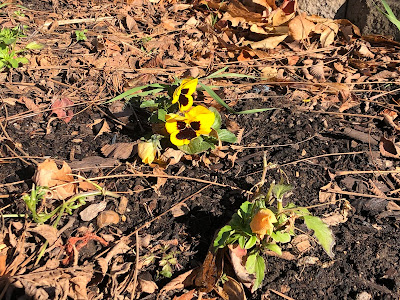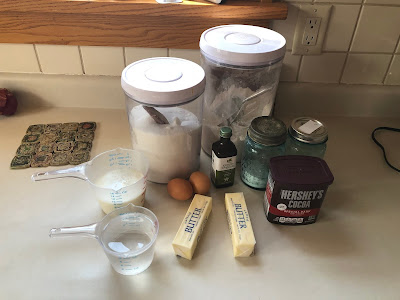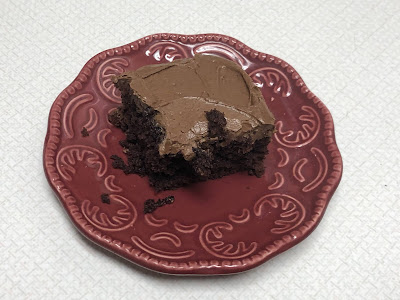November is half way done. The crazy world continues. Some days I feel hopeful. Some days, not so much. It's a number of things - the continuing craziness about the election, the virus which continues to surge here, the shortening days, the cold. We continue to put one foot in front of the other.
But it does not seem as frenetic as it had been. Maybe that is because the election is over. (I do know that Georgia is still there. ) Maybe it is because I have no major projects with deadlines at work. Garden cleanup continues. There are leaves to rake. There are still plants in the garage. (The number of plants in the garage is down to about ten.)
But it is time to find a new rhythm.
In the winter that means a watering schedule for the many houseplants. Some plants like the crotons like to be watered every week. Some plants are more on a once a month schedule. Those would be the plants that I want to be dormant. Orchids for example get watered differently depending on what they are planted in. If they are in bark, they get planted more frequently. If they are in sphagnum moss they can go weeks without watering.
This weekend I thought about the various hoyas that have proliferated over the summer. Many are in hanging pots. Watering hanging pots can be tricky, depending on how you feel about water on the floor. The absolute best is to have the handing plant directly over some other plant. It can then drip into that other plant. I have decided that the hoyas should be watered twice a month. So it was their weekend.
I hung these little prayer flags last weekend, in a thankful prayer. Our national embarrassment has been fired. While the next 65 days could be tense, there is an end date.
This next picture is one of the tree peonies that I grew from seed, about ten years ago. Tree peonies set their buds in the fall. The buds are so encouraging. You get a clear glimpse of what is to come. You can count the buds that will be flowers in 6 months. You also have to marvel at the cell structure of that bud. It will last all winter, out there, exposed to all that cold. The leaves and little branches will fall off. That is for the best so any snow or ice does not weigh down the plant.
Here is a lupine growing a little in the fall. It will in fact die all the way back. I like to think the fall growth does make it do better in the spring.
One of the pansies is struggling back, trying to avoid the deer at this point.
This coming week is to be warm again.
As I begin my reflections on this past garden season I have to put the rented sunny garden plot near the top of successes. For one thing that garden lives on at least for now. From that garden we have potted lettuce, parsley, mint and sage. Imagine - we had fresh sage in a meal recently.
I have 4 pots of lettuce, the first of which joined the dinner salad this last week. Those pots are in the garage at the moment and go outside when the temperatures get above freezing at night.
The parsley looks so green. I read that it will double in size every few weeks. It should at least grow enough to keep up with our kitchen needs.
When it gets really cold we will try to bring it in. That should give us parsley for the kitchen at least for a while.
Actually since it is the middle of November now, in only 4 months it will be the middle of March. That is almost spring time (some years.)
I will spend a little more time maybe this week writing down some of the things I learned from growing plants in the sunny garden plot this year.
When the outside plants have faded it is up to the inside plants to take up the slack.
Here is that white cattleya, in a video.
More buds on the orchids are coming.
Julia's recipe
The best chocolate cake
Here is the link to the other blog with all for Julia's recipes.
Hy-Vee is the big grocery store chain in Iowa (and now in seven other states in the upper midwest). We shop at the New Pioneer Co-op and at the farmers' market, but Hy-Vee is still a regular grocery shopping stop. There is something comforting about having a relationship with a grocery store, knowing where the bottled horseradish is or whether they regularly carry English cucumbers or Israeli cous cous and where they are, even in a very big store. With a florist and a drug store and a branch of a credit union and a dry cleaner and postal substation. Like a country store only really big.
Anyway, Hy-Vee mails out a sort of magazine from time to time with health articles and recipes and general chat. This chocolate cake recipe is from the Hy-Vee magazine, from a chef with Hy-Vee, who got the recipe from his grandmother who in turn got it from her downstairs neighbor when she was a young person living in an apartment in Des Moines.
Here is the line-up: 2-1/2 cups all purpose (aka regular) flour; 1/2 cup Hershey's dark cocoa; 2 teaspoons baking soda; 1/4 teaspoon of salt; 3/4 cup (that's 1-1/2 sticks) salted butter, softened; 2 cups white sugar; 1 teaspoon vanilla extract; 2 eggs; 1 cup buttermilk (or sour milk - I'll explain below) and 1 cup of boiling water. Plus 1 tablespoon of lemon juice or vinegar (not shown). Plus frosting of some kind.
I actually bought a little box of Hershey's dark cocoa. But I bet the cake would taste just fine with regular cocoa of any brand.
I had forgotten to take out the butter so I started by cutting it into pieces and leaving it on the counter to soften up. In the summer, this is fast, not so fast in the fall turning to winter. Plan accordingly.
I then took a minute to make myself some sour milk. I don't have a need for buttermilk very often, so I don't keep it on hand. Sometimes I use yogurt instead of buttermilk but I had concerns this time about viscosity. So I poured about 1 tablespoon of lemon juice into a 1 cup measuring cup and added enough milk to fill the cup. You could use vinegar instead. Not balsamic. The milk curdles and gets a bit clumpy. This is just what you want.
When the butter had softened, I beat it for about a minute to soften it further and then added the sugar a cup at a time, beating until it was smooth.
I think I beat the butter plus sugar for about 3 or 4 minutes.
After the sugar, then the eggs - one at a time, beating each one in.
I turned the oven on to 300 degrees. (Kind of surprising - usually cakes bake at 350. But who am I to argue with someone's grandmother from Des Moines?)
I also lubed up a pan, actually 2 pans - one 9"x9" and the other maybe 4"x7" which could be covered and mailed to family in Maine. More on this below.
The recipe called for baking in a 9"x13" pan. That's an area of 117 square inches. A 9"x9" pan is 81 sq. inches and a 4"x7"pan is 28 sq. inches, for a total of 109 sq. inches, which is close enough. Math! You can bake cakes in different sizes (and shapes) of pans if you are willing to do the math.
Back to stirring. I added the cocoa and the salt and the baking soda and beat them in.
I put the teakettle on the stove for the 1 cup of boiling water I would need later.
I added 1 cup of the flour and beat that in partially then added about 1/3 of the sour milk and mixed until the flour and milk were fully incorporated. I repeated with the rest of the flour and sour milk.
The batter was thick. While I had been adding and mixing, the teakettle came to a boil and I put 1 cup of boiling water into a measuring cup.
By the time I had finished with the flour and sour milk, the water had cooled a bit. But not much. I stirred it in. The batter got pretty thin.
It took a couple of minutes for the boiling water to be fully integrated into the batter. I was a bit dubious, but then again remembered that there was a grandmother behind this.
Here are the cakes going into the oven. They baked for about 45 to 55 minutes. Kind of a long time. But at a lower oven temperature.
Test with a toothpick or bamboo skewer after 45 minutes. Cake is done with there are crumbs or nothing at all. Any batter and it needs to stay in the oven.
Here they are out of the oven, looking very dark and chocolatey. The cakes needed to be cold to frost, so I cooled them in their pans on a rack to promote air circulation. I was not planning to take the cakes out of the pans, rather the one on the left would get mailed and the one on the right would go to our office and be served from the pan.
A word about frosting. I had about 1 or 1-1/2 cup of chocolate frosting in a little container in my freezer. Butter (or cream cheese) frosting freezes. I thawed it out; took the electric mixer to it to loosen it up, added a bit of milk and a bit of confectioner's sugar and was ready to frost. For those of you without frosting in the freezer, I recommend you go to the mearskitchen website where you will find recipes both for chocolate frosting and for cream cheese frosting. Either would be just fine.
Here is a square of cake. It was sturdy enough to eat out of hand, but also on a plate with a fork.
This cake is light and moist and chocolatey. We took it to the office to share with our staff. It took the better part of a week to be finished, and it was moist and light and chocolatey throughout the week.
I encourage you to consider sending baked goods to friends and relations from whom you are separated. That used to mean across the country. In these pandemic days, it could mean across town. Your grocery store will have disposable pans which will ship just fine, with a little ingenuity and some packing tape and maybe saran warp. If you send packages via priority mail, your baked goods will arrive within a few days and be just fine.
Odds and Ends
It is the season for falling leaves. Our season is particularly long as the sycamore tree holds onto its leaves until the bitter end.
Most people in the neighborhood pile their leaves up next to the curb. Then the leaf sucking crew comes around.
I just rake up cans full of leaves and give them to the Wednesday compost pickup. Actually I think it all goes the same place.
Yesterday I filled up many cans. The hosta foliage rakes right up at this point. That makes me think about cell structure again. (Remember the peony bud?) A hosta leaf or flower stalk will break down after about a month of being frozen. Siberian Iris foliage will never break down that way. I will still need to use clippers with them in March, after an entire winter.
While we cannot travel to see grandchildren, pictures do help a little.
Here is Christopher showing the person he calls Joey Biden a picture of his favorite trains. He understands that Biden likes trains too.
Since it is November I will start the selection process for the Picture Contest. I hope to launch the Sunday after Thanksgiving.
Being the middle of November means it is only 45 days until a new year. I think about planting seeds in early January. I suppose that means it is time now to think about seeds.
I am also starting new plants from cuttings now. I have some crotons started, along with some of Sue's geraniums. I should trim the big jade plants and start some of them. Hoyas will get some consideration.
Be safe.
Pray for the future, and that we survive the present.
Philip


















2 comments:
I totally agree,
Pray for the future and we survive the present!
I'm saving that cake recipe. It looks like a classic--chocolate on chocolate is an unbeatable combination.
I'm getting to this late--it's Monday afternoon. Your blog posts are a great way to start the week. Love the shot of Christopher sharing his train pictures with Joey Biden.
Stay WELL! Your hot spot is hotter than ours, so take extra care.
Post a Comment